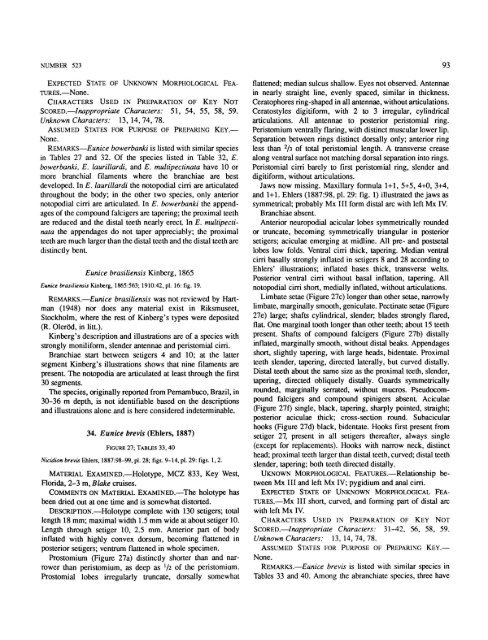A Review of the Genus Eunice - Smithsonian Institution Libraries
A Review of the Genus Eunice - Smithsonian Institution Libraries
A Review of the Genus Eunice - Smithsonian Institution Libraries
Create successful ePaper yourself
Turn your PDF publications into a flip-book with our unique Google optimized e-Paper software.
NUMBER 523 93<br />
EXPECTED STATE OF UNKNOWN MORPHOLOGICAL FEA-<br />
TURES.—None.<br />
CHARACTERS USED IN PREPARATION OF KEY NOT<br />
SCORED.—Inappropriate Characters: 51, 54, 55, 58, 59.<br />
Unknown Characters: 13, 14, 74, 78.<br />
ASSUMED STATES FOR PURPOSE OF PREPARING KEY.—<br />
None.<br />
REMARKS—<strong>Eunice</strong> bowerbanki is listed with similar species<br />
in Tables 27 and 32. Of <strong>the</strong> species listed in Table 32, E.<br />
bowerbanki, E. laurillardi, and E. multipeclinata have 10 or<br />
more branchial filaments where <strong>the</strong> branchiae are best<br />
developed. In E. laurillardi <strong>the</strong> notopodial cirri are articulated<br />
throughout <strong>the</strong> body; in <strong>the</strong> o<strong>the</strong>r two species, only anterior<br />
notopodial cirri are articulated. In E. bowerbanki <strong>the</strong> appendages<br />
<strong>of</strong> <strong>the</strong> compound falcigcrs are tapering; <strong>the</strong> proximal teeth<br />
are reduced and <strong>the</strong> distal teeth nearly erect. In E. multipectinata<br />
<strong>the</strong> appendages do not taper appreciably; <strong>the</strong> proximal<br />
teeth are much larger than <strong>the</strong> distal teeth and <strong>the</strong> distal teeth are<br />
distinctly bent.<br />
<strong>Eunice</strong> brasiliensis Kinberg, 1865<br />
<strong>Eunice</strong> brasiliensis Kinberg, 1865:563; 1910:42. pi. 16: fig.19.<br />
REMARKS.—<strong>Eunice</strong> brasiliensis was not reviewed by Hartman<br />
(1948) nor does any material exist in Riksmuseet,<br />
Stockholm, where <strong>the</strong> rest <strong>of</strong> Kinberg's types were deposited<br />
(R. OlerOd, in litt.).<br />
Kinberg's description and illustrations are <strong>of</strong> a species with<br />
strongly moniliform, slender antennae and peristomial cirri.<br />
Branchiae start between setigers 4 and 10; at <strong>the</strong> latter<br />
segment Kinberg's illustrations shows that nine filaments are<br />
present. The notopodia are articulated at least through <strong>the</strong> first<br />
30 segments.<br />
The species, originally reported from Pernambuco, Brazil, in<br />
30-36 m depth, is not identifiable based on <strong>the</strong> descriptions<br />
and illustrations alone and is here considered indeterminable.<br />
34. <strong>Eunice</strong> brevis (Ehlers, 1887)<br />
FIGURE 27; TABLES 33,40<br />
Nicidion brevis Ehlers, 1887:98-99, pi. 28; figs. 9-14, pi. 29: figs. 1,2.<br />
MATERIAL EXAMINED.—Holotype, MCZ 833, Key West,<br />
Florida, 2-3 m, Blake cruises.<br />
COMMENTS ON MATERIAL EXAMINED.—The holotype has<br />
been dried out at one time and is somewhat distorted.<br />
DESCRIPTION.—Holotype complete with 130 setigers; total<br />
length 18 mm; maximal width 1.5 mm wide at about setiger 10.<br />
Length through setiger 10, 2.5 mm. Anterior part <strong>of</strong> body<br />
inflated with highly convex dorsum, becoming flattened in<br />
posterior setigers; ventrum flattened in whole specimen.<br />
Prostomium (Figure 27a) distinctly shorter than and narrower<br />
than peristomium, as deep as x li <strong>of</strong> <strong>the</strong> peristomium.<br />
Prostomial lobes irregularly truncate, dorsally somewhat<br />
flattened; median sulcus shallow. Eyes not observed. Antennae<br />
in nearly straight line, evenly spaced, similar in thickness.<br />
Ceratophores ring-shaped in all antennae, without articulations.<br />
Ceratostyles digitiform, with 2 to 3 irregular, cylindrical<br />
articulations. All antennae to posterior peristomial ring.<br />
Peristomium ventrally flaring, with distinct muscular lower lip.<br />
Separation between rings distinct dorsally only; anterior ring<br />
less than 2 /3 <strong>of</strong> total peristomial length. A transverse crease<br />
along ventral surface not matching dorsal separation into rings.<br />
Peristomial cirri barely to first peristomial ring, slender and<br />
digitiform, without articulations.<br />
Jaws now missing. Maxillary formula 1+1, 5+5, 4+0, 3+4,<br />
and 1+1. Ehlers (1887:98, pi. 29: fig. 1) illustrated <strong>the</strong> jaws as<br />
symmetrical; probably Mx III form distal arc with left Mx IV.<br />
Branchiae absent.<br />
Anterior neuropodial acicular lobes symmetrically rounded<br />
or truncate, becoming symmetrically triangular in posterior<br />
setigers; aciculae emerging at midline. All pre- and postsetal<br />
lobes low folds. Ventral cirri thick, tapering. Median ventral<br />
cirri basally strongly inflated in setigers 8 and 28 according to<br />
Ehlers' illustrations; inflated bases thick, transverse welts.<br />
Posterior ventral cirri without basal inflation, tapering. All<br />
notopodial cirri short, medially inflated, without articulations.<br />
Limbate setae (Figure 27c) longer than o<strong>the</strong>r setae, narrowly<br />
limbate, marginally smooth, geniculate. Pectinate setae (Figure<br />
27e) large; shafts cylindrical, slender, blades strongly flared,<br />
flat. One marginal tooth longer than o<strong>the</strong>r teeth; about 15 teeth<br />
present. Shafts <strong>of</strong> compound falcigers (Figure 27b) distally<br />
inflated, marginally smooth, without distal beaks. Appendages<br />
short, slightly tapering, with large heads, bidentate. Proximal<br />
teeth slender, tapering, directed laterally, but curved distally.<br />
Distal teeth about <strong>the</strong> same size as <strong>the</strong> proximal teeth, slender,<br />
tapering, directed obliquely distally. Guards symmetrically<br />
rounded, marginally serrated, without mucros. Pseudocompound<br />
falcigers and compound spinigers absent. Aciculae<br />
(Figure 27f) single, black, tapering, sharply pointed, straight;<br />
posterior aciculae thick; cross-section round. Subacicular<br />
hooks (Figure 27d) black, bidentate. Hooks first present from<br />
setiger 27, present in all setigers <strong>the</strong>reafter, always single<br />
(except for replacements). Hooks with narrow neck, distinct<br />
head; proximal teeth larger than distal teeth, curved; distal teeth<br />
slender, tapering; both teeth directed distally.<br />
UKNOWN MORPHOLOGICAL FEATURES.—Relationship between<br />
Mx III and left Mx IV; pygidium and anal cirri.<br />
EXPECTED STATE OF UNKNOWN MORPHOLOGICAL FEA-<br />
TURES.—Mx III short, curved, and forming part <strong>of</strong> distal arc<br />
with left Mx IV.<br />
CHARACTERS USED IN PREPARATION OF KEY NOT<br />
SCORED.—Inappropriate Characters: 31-42, 56, 58, 59.<br />
Unknown Characters: 13, 14, 74, 78.<br />
ASSUMED STATES FOR PURPOSE OF PREPARING KEY.—<br />
None.<br />
REMARKS.—<strong>Eunice</strong> brevis is listed with similar species in<br />
Tables 33 and 40. Among <strong>the</strong> abranchiate species, three have
















